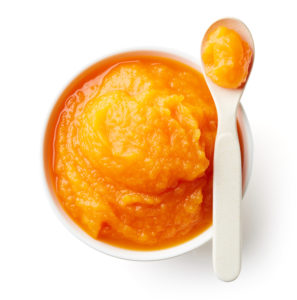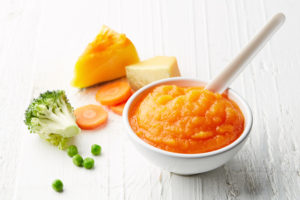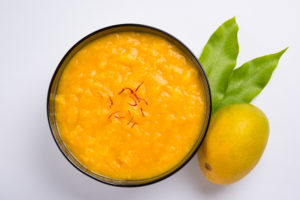The transition from breastmilk to solids isn’t automatic. Your little one needs time to adjust to baby food, discover preferences, and become used to new flavors. In this period, your baby needs all the love, care, and support you can provide.
Understanding the baby food stages would help you do this.
The different baby food stages would help you plan your child’s diet, prepare feeding schedules, and monitor progress. In addition, there are easy homemade recipes you can try out for each stage.
This article contains everything you need to know about stage 2 baby food; the options, timelines, and recipes. Furthermore, you’d find the major differences between stage 1 and stage 2 baby food options.
Let’s Get Started!
Table of contents
What Is A Stage 2 Baby Food?
Stage 2 babies are babies between ages 6 to 9 months.

These foods have a thicker texture compared with the stage 1 foods and are either strained or mashed. In contrast to stage 1 baby meals that are more watery, stage 2 foods are slightly more solid and easier to feed.
In addition, stage 2 baby foods usually combine more than one ingredient.
Common types of stage 2 baby foods include:
- Apples
- Bananas
- Chicken
- Oats
- Peaches
When To Start Stage 2 Baby Food
The truth is, the baby food stages aren’t automatic; there is no standard formula or unit of measurement for when exactly to start.

In fact, some babies may not be ready for stage 2 meals until they are seven or eight months old. However, you can be certain your child is ready for stage 2 foods if he/she:
- Shows good tongue reflex
- Does not push food out of his/her mouth
- Has become unsatisfied with stage 1 baby food
Stage 2 Baby Food Recipes: 5 Common Examples
Below are five great examples of stage 2 baby foods, what you need to prepare them, and how to make them. They are great in the sense that they provide your baby with the necessary vitamins and minerals they need and also provide energy.
1. Apple, Raspberry and Vanilla Baby Food Puree
What you need:
- 2 apples
- 1 cup raspberries
- 1/2 cup of vanilla bean pod
- 1/3 cup of water
How to prepare:
Add the apple chunks and water in a saucepan and steam in medium heat until the apples are tender. You can prick it with a fork to be sure it is done. After this, cut the vanilla seeds out of the pod and then add the vanilla and the raspberry to the saucepan containing the apple.
Boil for 5 more minutes.
Pour all the ingredients into a food processor or blender and puree until a smooth consistency is attained. Furthermore, you can add a little water if you need to.
2. Banana, Blueberry and Avocado Baby Food Puree
What you need:
- 1 banana
- 1 cup of blueberry
- ½ peeled avocado
How to prepare:
Put all the ingredients into a food processor and blend for about 2 minutes at a very high speed. However, if the puree is too thick, add some more water until you get your desired smooth consistency.
3. Berries and Apple Baby Food Puree

What you need:
- 1½ cup of combination of blackberry, blueberry and raspberry
- 2 apples
- ¼ tsp fresh rosemary
- ¼ cup liquid (which can be water, formula or breastmilk)
How to prepare:
Heat the apple and the liquid over medium heat in a saucepan for about 10 minutes. After this, you can add the berries and stir gently. Allow it to cook for 5 extra minutes.
Once this has been completed, you can place the apples, berries, and rosemary into a blender. Puree for about 2 minutes until you have achieved your desired consistency.
You can add additional liquid, like yogurt or milk if need be.
4. Banana, Cherry and Beet Baby Food Puree
What you need:
- 3 medium bananas
- 2/3 cup cherries
- ¼ cup red beets
- 1 teaspoon of fresh lemon juice
How to prepare:
Steam the beets for about 8 minutes. You can use a fork to check if it is soft enough. After this, place the cherries, beets, bananas, and lemon juice into a blender and puree for about 2 minutes.
You may add little water until your desired consistency is achieved.
5. Mango, Pear and Kale Baby Food Puree with Ginger

What you need:
- 2 mangoes
- ½ teaspoon ginger
- ½ cup kale
- 2 pears
- ½ cup water
How to prepare:
First of all, peel and pit the mangoes, then chop them. Core and chop the pears. De-vein and chop the kale too.
Once the cutting is completed, boil a little water over medium heat then put the mangoes, pears, and kale in a steamer basket over the boiling water. Cook for 6-8 minutes. After this, put the steamed mango, pear, and kale in the food processor. You can also add some ginger and puree until a smooth consistency is achieved.
Important Tips For Stage 2 Feeding
- Avoid Raw Honey: Children under the age of one should not consume honey. This is because it puts them at risk of an infection called botulism. If you plan to sweeten your baby’s purees, you can try other natural sources of sugar, like dates.
- Avoid nuts, seeds and popcorn: This is because it is easy to choke on these foods, as your baby is not yet able to fully control swallowing them.
- Practice safe feeding. Don’t leave your child alone with the food. Always keep an eye on your baby while feeding.
- Avoid Juice: According to the American Academy of Pediatricians (AAP) guidelines, juices are not allowed for children in this age range. Stick with breast milk, formula, or little water.
- Start Small: As we mentioned with the stage 3 baby foods, the best way to feed your child is to start small and increase progressively.
Conclusion
As your baby makes the switch from breast milk to adult food, it is important to remain patient, caring, and observant. In fact, we recommend speaking to your doctor before trying out new baby food. Once you get this approval, your baby can begin to try out these great meals. This also applies to picking stage 4 baby food options for your child.
References
Helena Čížková, Rudolf Sevcik, Ales Rajchl and M Voldřich (2009). Nutritional Quality of Commercial Fruit Baby Food. Czech Journal of Food Sciences 27:S134-S137. Accessed on 15th September, 2021 from https://www.researchgate.net/publication/236170955_Nutritional_Quality_of_Commercial_Fruit_Baby_Food
Yu-Chin Koo, Jung-Su Chang, and Yi Chun Chen (2018). Food claims and nutrition facts of commercial infant foods. PLoS ONE 13(2): e0191982. Accessed on 15th September, 2021 from https://10.1371/journal.pone.0191982
Patrizia Alvisi, Sandra Brusa, Stefano Alboresi, Sergio Amarri, Paolo Bottau, Giovanni Cavagni, Barbara Corradini, Linda Landi, Leonardo Loroni, Miris Marani, Irene M Osti, Carlotta Povesi-Dascola, Carlo Caffarelli, Luca Valeriani and Carlo Agostoni (2015). Recommendations on complementary feeding for healthy, full-term infants. Italian Journal of Pediatrics 41, 36. Accessed on 15th September, 2021 from https://doi.org/10.1186/s13052-015-0143-5

